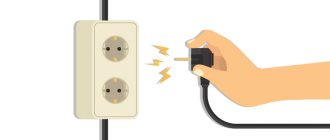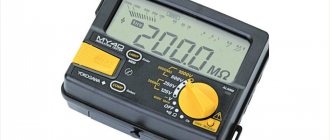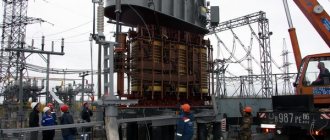The reliability of electrical equipment, as well as its service life, depend on properly organized technical operation. This includes measures to maintain electrical equipment in good condition, monitor its operation, preventive inspections, cleaning, lubrication, repairs to the extent and within the time limits specified in the maintenance schedule.
Electric Motor Maintenance
Timely implementation of such a set of measures helps to increase the operational period of electrical equipment, the reliability of its performance, reduce the risk of material losses due to downtime and guarantees safe operation. Electrical equipment maintenance keeps all components of electrical equipment in working order and in a safe condition. This applies not only to products installed in industrial and commercial areas, but also used in everyday life.
Correct installation of equipment, which must be impeccable, also plays an important role. It must be suitable for the conditions in which it is proposed to operate and the design load. Violation of any of these rules can lead to frequent failure of products.
Why should electrical equipment be maintained?
If you look at the statistics on the causes of accidents and fires, this issue will immediately become irrelevant, and the importance of maintaining electrical networks and installations in fully working order is undeniable. Regular maintenance of electrical installations by competent specialists solves this problem, reducing the risk of short circuits and other accidents to a minimum.
Our advantages
- qualified specialists
- efficiency
- guarantee of quality of work performed
Medium voltage cable maintenance
Includes testing of cables, contact groups, splices, cable joints.
The check consists of a visual inspection looking for signs of overheating and ground faults. PD testing is also carried out to detect possible voids in the insulation, improper installation, and contamination. These problems can lead to an accident if not detected in time.
Thermal imaging inspection is mandatory, especially at cable junctions and connections to equipment.
Maintenance Options
There are two main types of electrical equipment maintenance: scheduled and unscheduled. Scheduled service can be called basic: it is necessary to maintain the uninterrupted operation of a properly functioning installation and includes:
- checking switchgears, fastenings, electrical wires;
- inspection of protective coatings, insulation;
- checking the integrity and serviceability of the connected electrical wiring;
- inspection of places where wires pass through floors and walls;
- control of compliance with real loads;
- cleaning contacts;
- checking the serviceability and reliability of frames;
- tightening fasteners, etc.
Performed regularly according to the established schedule.
Unscheduled maintenance of electrical installations and electrical networks is the repair and elimination of problems that have already arisen, preventive actions to eliminate the possibility of a recurrence. It includes:
- partial disassembly of the body and mechanisms;
- repair of damaged parts of the electrical installation, replacement of defective parts;
- getting rid of sagging networks, restoring insulation;
- cleaning lamp fittings from dust;
- diagnostics of grounding and grounding;
- testing of dielectric protective equipment;
- insulation resistance measurement;
- thermal imaging examination, etc.
Unscheduled maintenance of electrical equipment is not performed regularly, but only at the request of the client.
Licenses and certificates
Electrical Troubleshooting
Electrical equipment examination: a professional approach to the most important issue
To determine the causes of failure of electrical equipment, it becomes necessary to search for a faulty unit or part. It is not always possible to guess at first glance or by characteristic signs the cause of a malfunction. Use 3 search methods:
- sequential functional analysis;
- probabilistic-temporal;
- splitting into halves.
In the first method, the basic parameters of electrical equipment or its electrical or circuit diagram are checked. In this way, deviations from the standardized values are found and the failed element is replaced. Although the method is tritely simple, it is not always possible to see the true cause of the failure. And the search sequence is not always optimal, and sometimes takes a long period of time.
Complex electrical products, assembled according to several circuits, and sometimes randomly, require a probabilistic-time method for finding faults. Here, data on failure-free operation or probability of failure is studied. In some cases, the following relationships are used:
- the time of testing a specific element of a product to the probability of its failure;
- probability of operation without failures by the time of verification.
Electrical panel maintenance
In this case, diagrams (electrical, structural, principle) of the product’s operation help. It is with their help that a functional model is built and a fault matrix is compiled from it. It is a list of signs of malfunctions and failures. Here we consider what change in the state of a particular element can cause an exit from the working state. They also determine the time spent on this check, the probability of failure-free operation or failure.
The half-splitting method is used for electrical products with a series connection of elements. First, elements are found that divide the product into two parts. It is believed that they have the same probability of failure. Then they divide those halves into 2 more parts and so on until they find what led to the failure.
It is believed that all these methods make it possible to detect a faulty part or component in the shortest possible time, as well as quickly repair and commission electrical equipment.
Contract for maintenance of electrical installations
A contract for maintenance of electrical equipment is concluded for a long period, and not for each maintenance case, and allows all work related to electrical installations and their serviceability to be performed by trained specialists. Such an agreement includes several very specific points:
- maintenance of transformer substations and distribution points;
- monitoring the condition of electrical panels (main switchboard, distribution switchboard, ShchS, ShchO, ShchU), electrical devices;
- checking grounding, power and lighting networks;
- checking lamps and fixtures;
- maintenance of cable lines.
Organization of operation and repair of electrical installations. Maintenance and repair forms.
Electrical installations are a set of machines, apparatus, lines and auxiliary equipment designed for the production, transformation, transmission, distribution of electrical energy and its conversion into another type of energy.
The most important condition for the operation of electrical installations is the timely completion of work related to scheduled preventive maintenance and periodic preventive testing of equipment and networks. Organizational and technical provisions for the operation of electrical equipment of enterprises are set out in the Rules for the technical operation of electrical installations of consumers, which are mandatory for all sectors of the national economy. In accordance with the specific conditions of each enterprise, the manager responsible for the operation of electrical equipment approves local instructions based on the PTE. The responsibilities of electrical technical personnel at industrial enterprises include the operation of electrical networks and electrical equipment from the boundary of division of operational responsibility between the supplying organization and the enterprise up to and including workshop installations.
The management structure for the operation of electrical installations is a set of interconnected controls that ensure the normal functioning of all elements of the enterprise’s power supply as one of the links in the overall production system.
Operation includes maintenance, repair, use and storage of electrical installations. Maintenance is a set of organizational and technical measures carried out during the period between repairs, aimed at maintaining the reliability and readiness of electrical installations in use and stored in reserve. To restore the service life of electrical installations, in addition to current repairs, major repairs are carried out, during which the equipment is taken out of use. The main part of the operation is the direct use of electrical installations.
The management of the entire energy sector of the enterprise is carried out by the Department of the Chief Energy Engineer of the industrial enterprise. The department organizes an uninterrupted and rational supply of production with all types of energy, as well as the operation of electrical, thermal power and plumbing equipment and networks.
For normal operation of electrical installations, each industrial enterprise must create a warehouse reserve of equipment, equipment, components and spare parts. This dramatically reduces the downtime of electrical installations during scheduled or unscheduled repairs due to the replacement of a failed element with a new one taken from the reserve. After repair, the failed element is sent to the warehouse as a backup. If it is impossible or impractical to repair it, the operational stock is replenished with a new unit. The stock of backup electrical installations must comply with the standards in terms of nomenclature and quantity.
The main task of operating the electrical equipment of industrial enterprises is to organize such maintenance of electrical networks and electrical equipment in which there is no production downtime due to malfunction of electrical installations, proper quality of electricity is maintained and the nameplate parameters of electrical equipment are maintained for the maximum time with minimal consumption of electrical energy and materials.
For reliable, safe and rational maintenance of electrical installations and keeping them in good condition, maintenance personnel must know the technological features of their enterprise, strictly observe labor and technological discipline, current safety regulations, instructions and other guidance materials.
Responsibility for the implementation of industrial safety regulations and safety regulations at each enterprise is established by job regulations approved by the management of this enterprise.
At each enterprise, by order (or decree) of the administration, an employee is appointed from among specially trained engineering and technical personnel (E&T) responsible for the general state of operation of the enterprise's electrical equipment. The rest of the electrical technical personnel of the enterprise is responsible for compliance with labor regulations and industrial safety regulations in accordance with their assigned responsibilities.
The administration of small enterprises provides maintenance of electrical installations, transferring their operation under a contract to a specialized operating organization or using appropriately qualified personnel on a shared basis with other similar enterprises.
Without the presence of appropriate electrical personnel, the operation of electrical installations is prohibited. The employee responsible for the electrical equipment of the enterprise must ensure:
· organization of training, instruction and periodic | testing the knowledge of subordinate personnel servicing electrical installations;
· reliable, economical and safe operation of electrical installations; development and implementation of measures to save electricity, specific standards per unit of production, as well as measures to increase the power factor;
· introduction of new equipment into the electrical sector, contributing to more reliable, economical and safe operation of electrical installations, as well as increasing labor productivity;
· organization and timely implementation of scheduled preventive maintenance and preventive testing of electrical equipment, equipment and networks;
· systematic monitoring of the enterprise load schedule and taking measures to maintain the regime established by the power system;
· organizing electricity metering, maintaining established reports and timely submitting them to higher organizations;
· Availability and timely inspection of protective equipment and fire-fighting equipment.
An employee who discovers a malfunction in the electrical installation or protective equipment must immediately report this to his supervisor, and in his absence, to a superior manager.
The following are responsible for accidents and defects in work on electrical installations:
· workers directly servicing electrical installations - for every accident and defective work that occurred through their fault, as well as for improper liquidation of the accident and defective work in the area they service;
· workers repairing equipment - for every accident and defective work that occurred due to poor quality of repairs;
· operational and operational repair personnel - for accidents and defects in electrical installations that occurred through their fault, as well as through the fault of the personnel subordinate to them. The operational electrical personnel of enterprises include all workers who service the production electrical installations of a given enterprise in shifts and are allowed to perform operational switching.
Operational maintenance is carried out by one or more employees. The decision on the number of operating personnel in a shift or at an electrical installation is determined by the person responsible for electrical facilities.
Operations personnel work according to the approved schedule. If necessary, with the permission of the person responsible for the electrical equipment of the enterprise, site, workshop, it is allowed to replace one duty officer with another.
Duty for two shifts in a row is generally prohibited.
During the shift, the senior electrical duty officer is required to fulfill the requirements of energy sales employees to reduce the electrical load, switch supply and transit lines, as well as disconnect individual lines in the event of an emergency in the energy supply organization.
The senior shift worker is obliged to immediately notify the dispatcher of the energy supplying organization about accidents that cause the shutdown of one or more lines supplying the enterprise, and coordinate with the head of the workshop or the dispatcher of the enterprise all operations related to the shutdown of technological equipment, with the exception of emergency cases.
Upon arriving at work, the duty officer must take over the shift from the previous one, and after finishing work, hand over the shift to the next duty officer in accordance with the schedule. Leaving duty without handing over your shift is prohibited. In exceptional cases, leaving the workplace is permitted with the permission of a superior employee.
In the process of accepting a shift, the duty officer is obliged to:
· familiarize yourself with the condition, layout and operating mode of the equipment on your site after a personal inspection to the extent established by the instructions;
· obtain information from the shift worker about equipment that needs to be closely monitored to prevent accidents or malfunctions, and about equipment that is under repair or in reserve;
· check and accept tools, materials, keys to premises, protective equipment, operational documentation and instructions;
· familiarize yourself with all records and orders for the time that has passed since his last duty;
· formalize the acceptance of the shift by making an entry in the journal or statement, on the operational diagram with your signature and the signature of the person handing over the shift;
· report to the immediate shift supervisor about joining on duty and about problems noticed during the shift acceptance process.
The duty officer who has passed his shift is obliged to report this to the person in charge of his shift. It is prohibited to accept and hand over a shift during the liquidation of an accident or switching equipment. If there is a long period of emergency response (more than two shifts), shifts can only be taken over with the permission of the administration.
The responsibilities of an electrician for servicing electrical equipment in the workshops of industrial enterprises include:
· preventive inspection of electrical equipment;
· inspection of protective equipment, fastenings, posts and control buttons;
· adjustment of starters, relays, devices and other electrical equipment;
· control over compliance with the rules of technical operation of electrical installations;
· performing work to eliminate faults in electrical equipment;
· carrying out preventive work to maintain artificial general and local lighting in good condition;
· checking and troubleshooting the grounding device;
· preparation of technical documentation for recording the operation of electrical equipment, registration of faults.
At industrial enterprises, the operation of electrical installations is carried out mainly on the basis of a system of planned preventive maintenance and repair (PPTOR). The essence of the PPTOR system is that, in addition to routine maintenance, electrical installations are subjected to scheduled preventive inspections, checks, tests and various types of repairs at certain intervals.
The PPTOR system allows you to maintain normal technical parameters, partially prevent failures, improve the technical characteristics of equipment as a result of one or another modernization, and increase the reliability and safety of electrical installations.
The PPTOR system involves the selection and application of a rational form of operation of electrical installations at the enterprise. The organizational form of operation affects the production capacity of repair bases, the quality of repairs, the number of energy workers, repair times and the cost of repairs.
There are three forms of operation of electrical installations:
· centralized, providing for the implementation of all types of PPTOR work with an annual planned labor intensity of up to 300 thousand man-hours by the operation and maintenance personnel of the Service of the Chief Power Engineer of the enterprise. The advantages of this form of operation are better equipment of the technical repair base, specialization of work, reduction of production space and the number of repair personnel;
· decentralized, providing for the implementation of most of the repair work of PPTOR with an annual planned labor intensity of up to 2000 thousand man-hours by repair services of production departments. The advantages of this form of operation are better efficiency in performing work;
· mixed, providing for the implementation of all types of PPTOR work with an annual planned labor intensity of up to 5000 thousand man-hours or more. Repair work is carried out by the repair services of production departments and the personnel of the Chief Power Engineer Service. The advantages of this form of exploitation depend on the degree of centralization.
The operation and repair of all electrical installations of the enterprise (general plant and production shops) are the responsibility of one electrical shop (or power shop), subordinate to the chief power engineer of the enterprise. The electrical engineering personnel of the entire enterprise are technically and administratively subordinate to the chief power engineer. The centralized system is used, as a rule, in smaller enterprises, but there are examples of its application in large enterprises. The disadvantages of such a system include the difficulty of managing a large number of electrical personnel and a decrease in the responsibility of process personnel for compliance with the conditions for the safe operation of electrical equipment.
During operation, increasing the safety and reliability of electrical equipment is greatly facilitated by the correct organization and timely implementation of maintenance (TO) in full. The main task of maintenance is to maintain electrical equipment in working condition. Maintenance work is carried out at the installation site of electrical equipment.
Maintenance of electrical equipment is divided into production and planned.
Production maintenance includes operational maintenance, which is carried out by personnel servicing electrified working machines and mechanisms (cleaning and inspection before and after work, management, work monitoring), and duty maintenance performed by electricians on duty (making shutdowns and switching, eliminating minor malfunctions, making the necessary adjustments). During scheduled maintenance, electrical equipment is cleaned, checked, adjusted, lubricated and, if necessary, short-lived, easily removable parts (brushes, springs, etc.) are replaced.
Carrying out maintenance allows you to timely detect and eliminate malfunctions that arise during the operation of electrical equipment, or the reasons that may cause malfunctions. Thus, at its core, maintenance is a preventive measure aimed at ensuring the operability of electrical equipment and preventing the occurrence and development of faults. If faults are detected during maintenance, the elimination of which requires disassembling electrical equipment or using special equipment, the issue of the need for repairs (current or major) is decided.
Scheduled maintenance, regardless of the form of operation, is carried out according to a predetermined schedule through strictly established periods of operation of electrical equipment. The greatest effectiveness of scheduled maintenance is achieved when the frequency and scope of work performed during each such maintenance are most consistent with the design features of electrical equipment, its technical condition, operating modes and other operating conditions.
Advantages of our company
You do not need to have your own staff of electrical engineering specialists in your enterprise (office, restaurant, store, etc.). There is no need to support them, train them and be responsible for their work. After all, you can enter into an agreement with our company, and WE will fully service your electrical equipment and monitor its proper condition. We work with equipment of any complexity, we have the necessary permits for this type of activity, our specialists are highly qualified and have extensive experience.
Preparation and theory
Each maintenance task has its own processes, and the technician must know which one to choose for a given element of the power grid. Figure 1 provides an example of basic tests.
Figure 1. Plans and methodologies can be found in some electronic predictive maintenance systems.
Tables like these help you plan your examination and select the right test equipment. Fortunately, modern universal instruments make it possible to automate the inspection of power systems of any age.
Prices for servicing electrical installations and electrical equipment
| Name of service | Unit price, rub. |
| Maintenance of electrical equipment of buildings | from 8 500 |
| Maintenance of transformer substations | from 8 500 |
| UPS Maintenance | from 8 500 |
| Maintenance of diesel generator sets | from 10 000 |
The cost of maintenance of electrical installations depends on the scope of work and the area of the facility, and is therefore set individually. The information in the price list section will help you determine the approximate cost of services. For a more specific determination of the cost, you can call us and get detailed advice, as well as arrange a meeting, inspection of the property, and conclusion of an agreement.
You can contact representatives of the electrical laboratory and call specialists by phone (495) 172-48-46, email, or online chat. Fill out applications, each request is registered and processed within 5 minutes. Maintenance services are provided on a day and time convenient for the customer.
Reviews from our clients
Medium voltage distribution equipment and switches
Medium voltage equipment has the widest range from 3 kV to 40.5 kV and plays a key role in transmitting energy to consumers. The most common operating voltage range is 6-30 kV. Values vary in different countries due to history and technological background, which must be taken into account when choosing test equipment.
Distribution equipment connects the enterprise network to the substation. This area requires visual inspection of connections and partial discharge inspection (including high frequency UHF and transient earth voltage, TEV), ultrasonic and thermal imaging inspections.
Component testing includes checking:
- circuit breakers and safety switches;
- relay;
- auxiliary equipment.
Capital
Another main type of repair of electrical equipment includes the one mentioned above. The process involves 80% wear, which requires systematic replacement of not only individual parts and components, but also complete units. In some cases, the concept is associated with modernization, which involves improving the system without losing its original properties.
The replacement and implementation of major repairs is regulated by the PTE and local documentation, passports of energy facilities. A mandatory condition for carrying out full repair work is the issuance of technical specifications for the implementation of the relevant actions. There are other subtleties here that should be studied by administrative and technical personnel.
Maintenance of low voltage equipment
Low voltage distribution equipment is found everywhere.
Testing includes checking switches and fuses, circuit breakers, relays, motor controllers, and auxiliary equipment. In addition to the visual inspection, instrumental inspections are carried out: ultrasound and thermal imaging.
Stages of work
Maintenance of lighting electrical installations is necessary to maintain operability throughout the entire operational period, as well as during transportation and storage. It consists of 4 stages:
- Inspection: daily observations, monitoring the proper operation, checking networks and equipment, troubleshooting, degree of compliance with safety standards.
- Maintenance during operation: cleaning, lubrication, adjustment of cooling systems.
- Testing (monitoring): checking reliability, operability, safety and operating conditions during the period between repairs. Carried out strictly according to regulatory documentation. The main task is to identify problems in a timely manner and prevent an emergency.
At each enterprise, there is sole maintenance of electrical installations up to 1000 V. This includes switches, lighting devices, electrical panels, meters, sockets, protection devices, cable routes.
Emergency
Emergency types of electrical equipment repairs and their characteristics are determined by an emergency situation involving the failure of electrical installations. Any breakdown at a substation (switching devices, power transformers, cable lines, overhead lines) requires the implementation of the appropriate type of repair work. The presented variation assumes maximum speed in eliminating the problem and powering consumers. Such repair procedures are carried out by specialized high-voltage teams or HVB.
It should be noted that this is an extreme scenario. Routine maintenance should prevent this from happening. Emergency situations can often arise due to human factors, for example, the work of third-party organizations in the security zone of overhead lines. Emergency situations often lead to greater damage to the enterprise than planned maintenance.
Unscheduled
It is simply impossible to plan and take into account everything, so unscheduled repairs of electrical equipment at an enterprise are necessary. During routine inspections and tests, defects appear that require elimination. In the absence of action to eliminate defective components or assemblies, there is a significant risk of more serious emergency situations.
In most cases, this category involves routine repairs. However, in some situations, decisions may be made to overhaul or replace equipment completely at the discretion of the chief engineer and senior personnel. It all depends on the balance of safety/reliability/efficiency.
Categories of complexity of maintenance
The first category is the most common. This includes a major overhaul of the mu series school's electrical supply and includes:
- external inspection;
- checking compliance with regulatory requirements;
- cleaning the surface of equipment from dust;
- analysis of fastening strength;
- eliminating the possibility of overheating;
- correction of obvious damage.
The second category has similar requirements as the first. Equipment repair is added.
In the third category, it is necessary to replace individual parts and assemble new equipment.
The fourth involves a complete repair of in-house engineering power supply systems, which is included in a major change in the operation of the equipment.
Planned
The repair campaign is planned before the start of the calendar year. All actions that are coming for the future are outlined in plans, which predetermines this group. This does not include emergency types of work on the repair of electrical equipment, mainly the overhaul of substations. The formation of the list depends on the technical department, which identifies electrical installations that require maintenance.
The documentation is approved by the chief engineer and communicated to the cable/overhead lines, RP/TP/KTP foremen, and administrative and technical personnel. In most cases, the calculation of bonuses for employees depends on the fulfillment of the presented indicator. Information is provided to higher structures about the progress of the repair campaign, and the accident rate of the networks depends on it.











